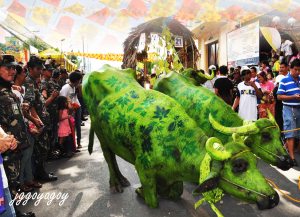Every May 14, residents of Pulilan in Bulacan, San Isidro in Nueva Ecija, and Angono in Rizal, commemorate the feast day of San Isidro de Labrador, patron saint of farmers, with the carabaos sharing celebrity status.
But while the three towns have similar cause for marking the day of the farmers’ patron saint, it is Pulilan town that always come on top as a sea of curious spectators gather to witness the carabaos’ special talents.
The select carabaos of Pulilan, on this special day, do not only display their enhanced “beauty” but they also showcase their unusual but remarkably surprising talent—that of genuflecting or kneeling or gyrating or doing the jig while kneeling. Because of this display of talent, the observance of the feast day in Pulilan is also called “The Kneeling Carabao Festival”.
The carabaos are brought by their owners in front of the church on this special day and are made to display their
famous trait. This peculiar show, no doubt, is a reason enough for the influx of local and foreign tourists in Pulilan town.
Known as the farmers’ best friend and indispensable ally in different kinds of farm works, the carabaos are given royal treatment on this day. In preparation for the festival, according to their owners, the carabaos are “retouched” starting early in the morning in order to be ready for the parade that takes off early in the afternoon on the same day.
Part of the preparation includes making the carabaos “kings and queens” wherein their “crowns” (horns) are
rubbed with oil for a shining sheen; their backs are adorned with special clothes serving as their capes; their bodies are scrubbed, cleaned, and painted; their legs are designed with knee caps; and their hooves, too, are either made shiny or painted with apt colors.
As in past celebrations, long before the clock ticked at 2:00 pm last May 14, which was the time set for the start of the event, the main streets of Pulilan town were already crowded with thousands of people, residents, and tourists alike.
They were eagerly awaiting for the passing of hooves, too, are either made shiny or painted with apt colors.
As in past celebrations, long before the clock ticked at 2:00 pm last May 14, which was the time set for the start of the event, the main streets of Pulilan town were already crowded with thousands of people, residents, and tourists alike.
They were eagerly awaiting for the passing of incessant popular request from the throng of onlookers, the carabao owners could not do anything but oblige to the delight of the spectators.
The San Isidro Labrador church, of course, was the ultimate destination of the animals’ show of “religiosity”.
The carabaos knelt at the signal of their master as they passed one by one in front of the church. The kneeling was
for a few minutes with the carabaos not minding people and their reactions. What appears to be more interesting and greatly appreciated by the onlookers was not only the carabaos’ demonstration of their ability to kneel but also to “walk” on their knees like penitents in front of the church. This scenario left onlookers in a blaze of awe and surprise.
May 15, according to the Catholic Church’s account, is the day for the patron saint of farmers—San Isidro de Labrador (laborer) also known as Isidore the Farmer. The account said that Isidore was a
laborer who was always late in tending to his farm chores yet always finishes his job at the end of the day.
One day, his co-laborers complained to their master that Isidore was always late for work in the morning. Prompted with curiosity, the master went to the field and investigated the claim by himself. The master was astounded by what he saw. He found Isidore at prayer while two angels were helping him with his field works thus making his work equal to that of three laborers. Struck with awe, the master knelt and prayed before the
angels. San Isidro de Labrador was also known for his goodness toward the poor and animals. He was then called the patron saint of farmers.
Among the residents of Pulilan town, nobody can really tell how this practice of making the carabaos kneel in
front of the church started. However, the residents have been doing this practice for many, many years already.
Accounts said that the farmers took it upon themselves to make it a vow to participate in the parade, thus, they make big preparations for this occasion. In fact, many other residents from different towns in Bulacan come over to Pulilan town just to participate. This tradition continues to be passed on among generations
